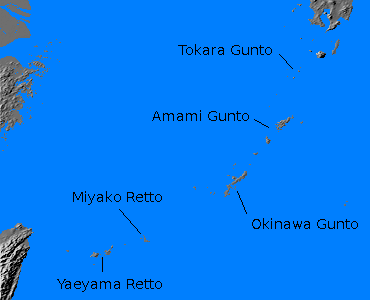![]() The Pacific War Online Encyclopedia
The Pacific War Online Encyclopedia
|
| Previous: Ryujo, Japanese Fleet Carrier | Table of Contents | Next: S Class, British Destroyers |

The Ryukyus (Nansei Shoto in Japanese) are an island arc with 161 islands and a total land area of about 1850 square miles (4790 km2) stretching 650 miles (1050 km) from Kyushu, the southernmost of the main Japanese home islands, to Formosa. The island arc separate the Philippine Sea from the East China Sea. The islands are composed mostly of marine sedimentary rock but with a number of volcanoes, including Suwanose-jima (129.715E 29.641N), which is one of the most active volcanoes in the world. The islands are almost devoid of natural resources, other than some timber on a few of the wilder islands.
Okinawa
is the largest of the Ryukyus, with a land area of 463 square miles (1200 km2),
and it had a
sizable population in 1941. Amami Oshima was the staging point for some of the Army forces participating in the Centrifugal Offensive, and there were satellite airfield on nearby Tokunoshima and Kikai by 1945. Miyako Retto and Ishigaki had airfields that threatened the Okinawa landings but were neutralized by British carriers.
The Ryukyus are culturally and
linguistically distinct from
either Japan or China,
but paid tribute to both before being incorporated
into the Japanese Empire in 1879. (The word
"Ryukyu" is thought to be a Japanization
of the Chinese name, Liukiu.) Commodore Perry of the United States
signed a treaty of peace with the kingdom of the Ryukyus in
1854. They were the only part of the Japanese Empire outside
of the home islands to remain Japanese
possessions after the war, though the U.S. long retained control and
still has
military bases on Okinawa. The population in 1940 was 818,624, of which
463,000 lived on Okinawa. However, in spite of the high population
density, the islands were poorly developed, with just 331 civilian
motor vehicles in the entire chain.
The islands are quite rugged, with a
subtropical climate and, in
most places, considerable forest cover. The smaller islands of the
southernmost Yaeyama Retto group were still heavily infested with malaria. There are numerous
natural limestone
caves, which the Japanese converted to almost impenetrable
fortifications during the
battle for Okinawa in April of 1945. The island were heavily garrisoned
by 1945, but all except Okinawa were bypassed.
References
Morison (1959)The Pacific War Online Encyclopedia © 2006, 2010-2011 by Kent G. Budge. Index